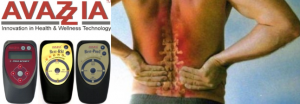
Avazzia devices stimulate the nervous system, just as TENS devices do, but that’s where the similarity ends. Avazzia technology works differently than most TENS devices, first by using microcurrent and second by targeting the C-fibers of the nervous system (most TENS devices work on the A- and B-fibers). C-fibers stimulate the production of neuropeptides and other regulatory peptides, which the body uses to heal itself.(1)
Because Avazzia features an interactive response, the microcurrent signal is constantly being adjusted to changes in tissue characteristics. Thus the body doesn’t “habituate” or “accommodate” the microcurrent signal. The device measures tissue response and adjusts the microcurrent signal. In surveys, users report that using Avazzia treatment lessens pain, improves sleep and dramatically increases users’ ability to return to daily activities.
What Is TENS?
TENS units — Transcutaneous Electrical Nerve Stimulation — use electrical currents passed through the skin to stimulate nerves. TENS units use a variety of power sources — some are plugged into the wall, use 9V batteries or other batteries. TENS also use a range of methods to conduct current through the skin including onboard electrodes or lead wires connected to adhesive pads, masks, wraps and other fabric-like options
Avazzia uses two AA batteries and all of the above methods to conduct microcurrent to the patient — onboard electrodes, lead wires with pads or accessories such as Y-electrode and pencil electrode, and fabric-like options including wraps, gloves and socks. Avazzia’s proprietary software and microchips mean a better engineered, more effective treatment method than a traditional TENS.
Avazzia: Life Without Pain